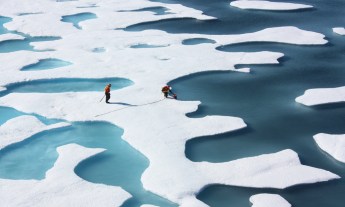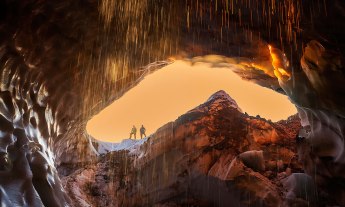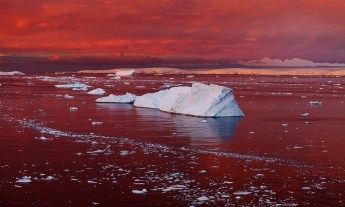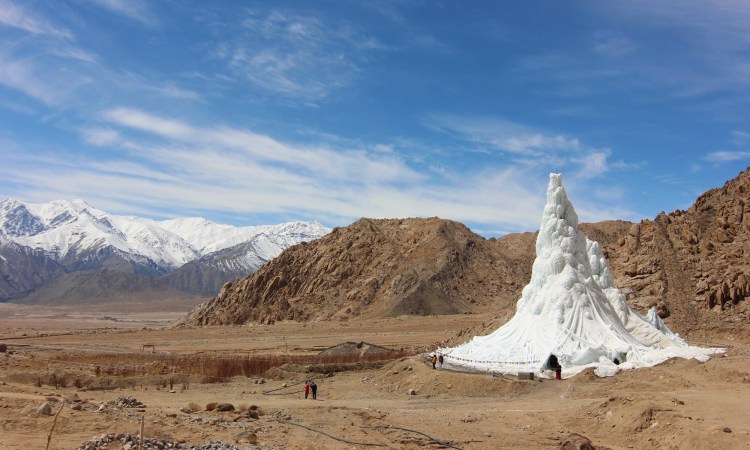
Using glacier water and pipes (with a big boost from gravity), Indian engineer Sonam Wangchuk has devised a way to store water in the dry high desert.
Amid the dusty peaks of the Himalayas in North India, fairytale-like ice towers soar 80 feet into the sky. They may look enchantingly unreal, but these cones — formed out of glacial meltwater — represent a very real way to help counter some of the effects of climate change.
These ice towers are called “ice stupas,” thanks to their resemblance to the Buddhist monuments used for prayer and meditation. In fact, says Sonam Wangchuk, an engineer and the mind behind the ice structures, “elderly people come and prostrate themselves or pray beside them.”
After all, the ice stupas are a monument of sorts — to the earth and to problem-solving.
More than 11,000 feet above sea level, Ladakh is an arid region filled with spectacular mountains, vast blue skies and some 200 villages. The climate is demanding: Winter temperatures often dip below -20 degrees Fahrenheit, and less than two inches of rain fall over the course of a typical year. Ladakhi communities — which depend on farming to live — rely on the glaciers perched above them in the higher mountains for their water supply. The bond between human and glacier is so strong that one local folk tale tells the story of how mother ice and father ice came together to beget baby ice, who provides for the people.
In recent years, the snowline has been shifting due to climate change. “We can see that glaciers are receding, and they’ve gone higher and higher,” says Wangchuk. Glacial streams are beginning to dry out before the summer even starts, creating water shortages during the spring when newly planted crops are vulnerable.
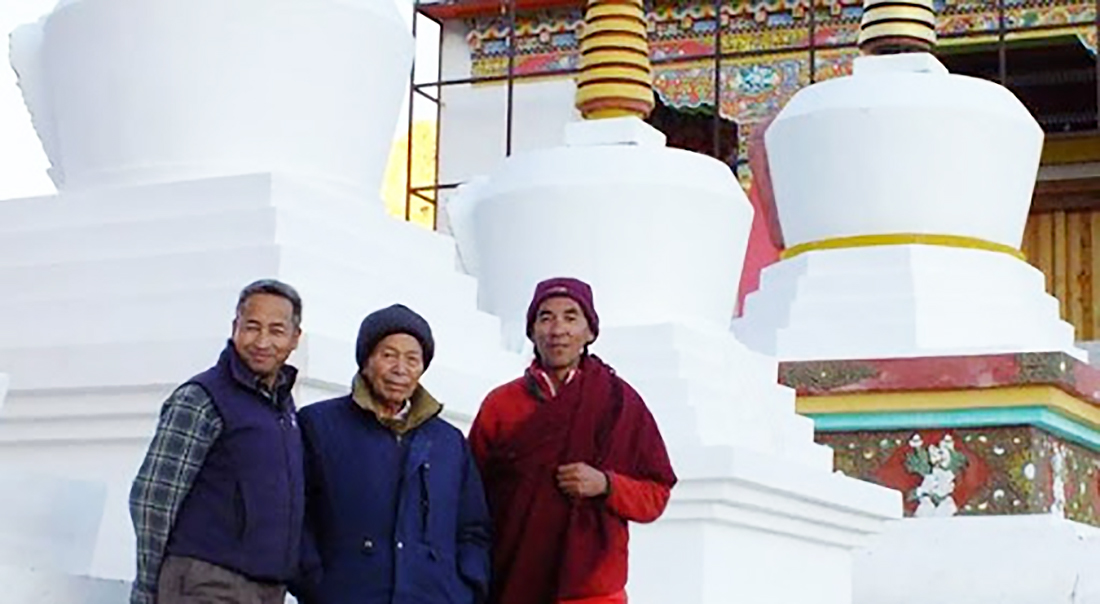
So, a couple of decades ago, retired Ladakhi civil engineer Chewang Norphel (TEDxIIMUdaipur talk: Making glaciers) hiked up to observe the changing streams for himself. Then he began to build artificial glaciers by creating closed embankments near the glacial beds and diverting meltwater into them. Held there, the water froze in the winter. It stayed until the warmer weather came and it could be sent streaming downhill for summer use. Norphel built a dozen reservoirs, earning the nickname of “Ice Man of Ladakh.”
However, Norphel found that doing construction work many miles above the villages was costly and backbreaking, and upkeep was also tough. Sometimes, too, the water evaporated before it could be used. A few years ago, he shared his worries with a younger man, mechanical engineer and teacher Sonam Wangchuk.
Wangchuk is a self-described problem solver. “If there’s a stone in the path,” he confesses, “I can’t go on further without removing it because it could hurt someone.” Troubled by the limitations of the traditional school system, he cofounded an alternative school in Ladakh in 1988. The Students’ Educational and Cultural Movement of Ladakh, or SECMOL, has become known for its solar-powered buildings (which students helped build), its largely student-run campus, and its offering classes in the local dialect.
Listening to the Ice Man’s problems, Wangchuk was intrigued. It was an exciting challenge — something he’d loved since he was a boy when his grandmother amused him with puzzles and riddles. Could he find a way to prevent the collected water from melting before the summer? Could the water be brought down into the valley, eliminating the need to make an uphill trek to release it?
The design that Wangchuk came up with was based on “concepts found in high school physics,” he says. The key principle used was that within a pipe, water stays level. Simply put, if the water at one end of the pipe is at X height, then on the other end it will rise or fall to the same X height.
Always looking for ways that his students can tackle real-world problems, Wangchuk enlisted a group of young people from SECMOL to work on a pilot project in the winter of 2013-14. He believes that hands-on opportunities give kids the confidence to grow and take on life’s bigger problems, or as he puts it, “lots of experiences of having tried, failed, tried, failed … and then succeeded.”
For the pilot project, “we chose a spot that was fully exposed to sunlight and located at the lowest altitude — and hence warmest — possible in the whole of Leh valley,” writes Wangchuk on his website. Building the prototype took one month. When the team members saw the cone of ice rise to about 23 feet, they were delighted.
But Wangchuk says they’d consider the experiment a success only if the ice remained until the first day of May. When that day came, the ice stupa was 10 feet high and still providing water to the surrounding earth. The stupa lasted another 17 days, proving that bigger masses of ice in higher altitudes might last until the summer.
In November 2014, Wangchuk launched the construction of the next ice stupa. The spiritual head of the community, His Holiness Che Tsang Rinpoche, asked for it to be constructed on the premises of his monastery in Phyang Valley. As a passionate advocate of the environment and sustainable development, he wanted to support this project.
Wangchuk’s team planned to tap into the water of a stream flowing about one-and-a-half miles up the slope from the monastery. Into this stream they placed one end of a mile-and-a-half-long pipe, which ran downhill via a tunnel. When the pipeline reached the grounds of the monastery, it made a 90-degree turn, jutting out of the ground and rising — perpendicular to the ground — to roughly 35 feet, its mouth facing the sky. Since the mouth was at an elevation of about 65 meters above the monastery in the high mountains, the water should mirror that height at the other end of the pipe and rise 65 meters over the valley. (To see a diagram of how this works, go here.)
When construction began, several hundred locals volunteered to assist, lining up on the slope to dig the tunnel, lay the pipe, and then shovel earth over it. They also planted 5,000 saplings around the planned ice stupa, greening the valley. “Generally, in Ladakh, there is a rich tradition of people coming out to help,” says Wangchuk. “And that comes because it’s a very harsh and difficult place, and you cannot survive if you only take care of yourself.”
By March 2015, the the team was ready to open the pipe. When they did, the stream water entered and began to flow through it down the slope. As the water moved, it began speeding up thanks to gravity. By the time it reached the other end, its momentum helped it to rise and gush up before smashing against the fountainhead blocking the pipe.
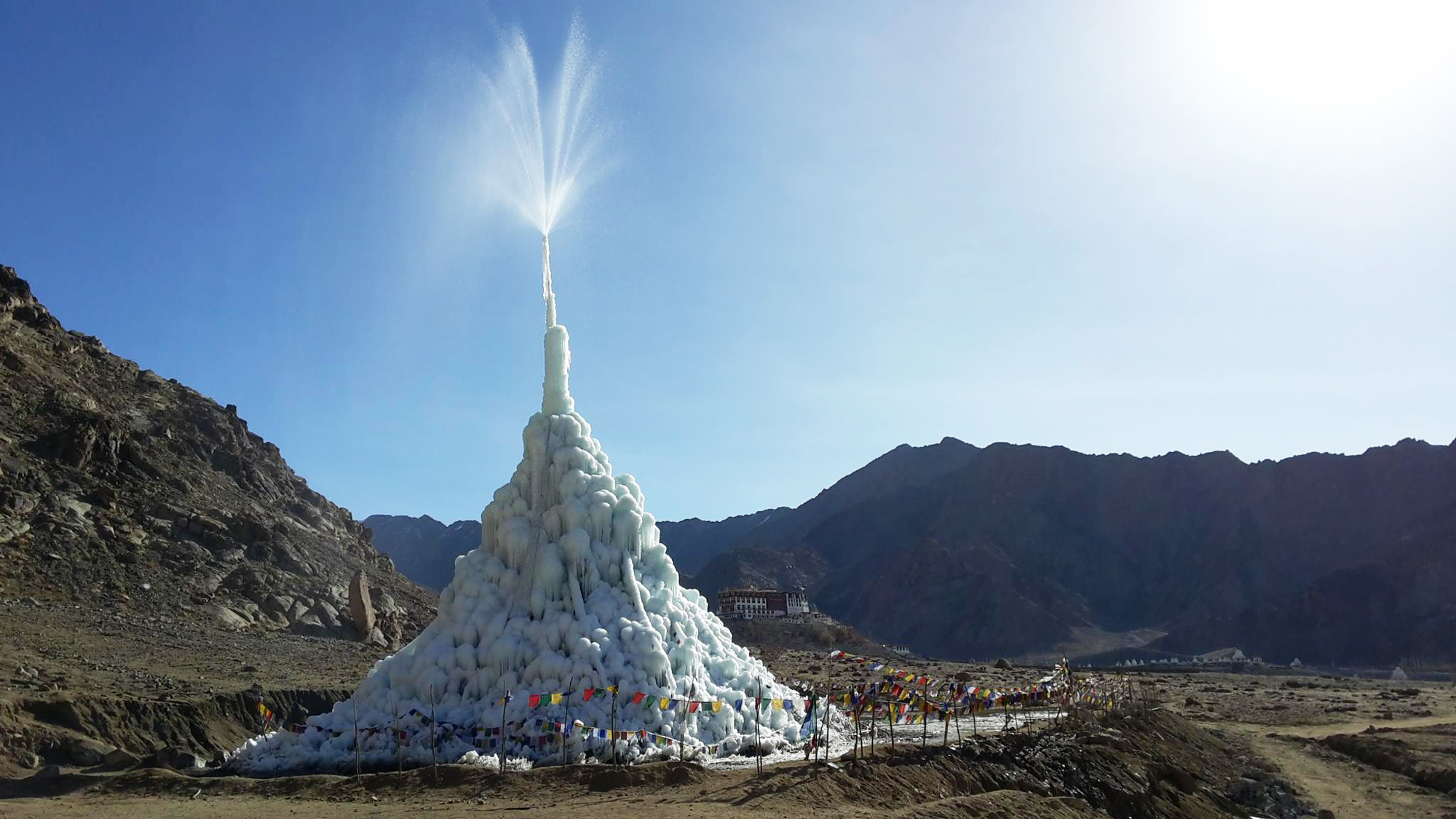
The fountainhead was placed strategically, with the aim of splintering the water into a fine spray and sending it shooting in all directions like the florets on a dandelion head. As the miniscule drops broke out of the pipeline and met the -10 to -20 degree winter air, they froze. Bit by bit, these pieces of ice accumulated and began to grow upward like a stalagmite.
Gravity, speed, slope, acceleration, temperature – these physical forces all worked with the water and earth to build the ice stupa. It was a “solution with no rocket science,” according to Wangchuk. Once the basic framework was put into place, everything took care of itself, “using no machines or energy except gravity,” as he put it. The tower rose to a height of 64 feet, containing nearly two million gallons of water.
With the stupa complete, the team waited. As April came, temperatures rose. The ice tower released a little rivulet of water that trickled into the serpentine channels circling the beds of saplings. The water continued to flow, but even when temperatures peaked in the upper 60s in mid-May 2015, the tower stood. It stayed through June, shrinking slowly until finally disappearing in early July.
Last winter, Wangchuk and his students built twin ice stupas near the previous one, and they reached 78 feet. “I really salute these young heroes without whom I would have achieved nothing,” he writes in his blog about his team. “They worked continuously for three months through the coldest times and hardest challenges, often risking their own lives.”
On seeing the stupa in Phyang Valley, many people in the community felt a spiritual connection to it. Not only was a part of their revered glaciers now standing in their own valley, but there was hope for water. They strung colorful prayer flags around it to break the wind and protect the ice, further highlighting its resemblance to Buddhist stupas.
But this ice tower was only a “microcosm” of his vision, says Wangchuk. It was time to launch the next phase of the project. Beginning in November 2017, he and his team created half a dozen smaller stupas along the banks of the Indus streams as a pilot for that second phase. Because these stupas are built right next to the streams, the pipes — and costs — are much smaller. The new prototypes did well, saving and freezing water during the winter and replenishing the stream’s dying spring flow. Their water was carried down into the valleys via the natural stream beds.
If hundreds of these stupas were in operation — and Wangchuk hopes someday there will be — they could have the potential to fully compensate for the diminished glacial flow. However, the stupas are not without critics, as some farmers say that meltwater is being diverted away from their land. Also, since weather patterns are shifting in unpredictable ways, the stupas may need to be constantly tweaked and adjusted in coming years.
Right now, Wangchuk is looking ahead to the opening of his new university (funded by prize money when he won the Rolex Award for Enterprise). Created to be a center of innovation to address mountain residents’ multiplying problems, the Himalayan Institute of Alternatives, Ladakh, will admit its first group of about a dozen graduate students the fall of 2019. One of the many issues that students will be encouraged to focus on is climate change, “so that we are not caught unawares,” Wangchuk says.
Meanwhile, there are more stupas to be made this winter and much more work ahead for Wangchuk as he continues to think of new ways to help this part of the planet that he holds so dear. Quoting Marshall McLuhan, he says, “There are no passengers on spaceship earth. We are all crew.”
All images courtesy of Sonam Wangchuk.
Watch Sonam Wangchuk’s TEDxGateway talk here:










